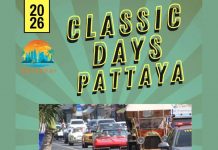One’s mind tends to wander during tours of even the most fascinating of historical places, as you’re torn between listening and trying to see the object described. But something my guide said suddenly caught my attention…
“Just over a hundred years ago, during the reign of King Rama V the Great, Phrae wasn’t part of the Kingdom of Thailand. It was a strategic gateway to the Lanna Kingdom with its own authoritative power and ruler. And this house you’re in belonged to the last independent ruler, Chao Luang Phiriyachai Thepawong”
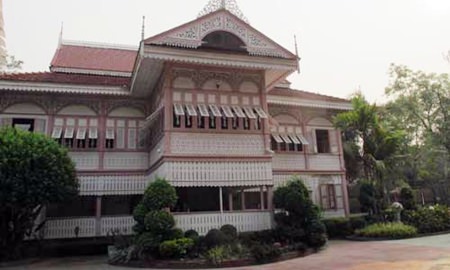 Sweet pink colonial building of Ban Vongburi.
Sweet pink colonial building of Ban Vongburi.
“Wait,” I blurted. “Phrae province wasn’t part of Thailand?” My surprise caused me to echo the guide who was showing me round Khum Chao Luang Mueng Phrae.
“Yes, till 1902” continued the guide. “When there was the uprising by the Burmese Shan. Thai troops were sent from Bangkok to end the rebellion in Phrae. The last Chao Luang (governor) of Phrae fled the country and never came back. Phrae lost its independence and was incorporated into the Thai state.”
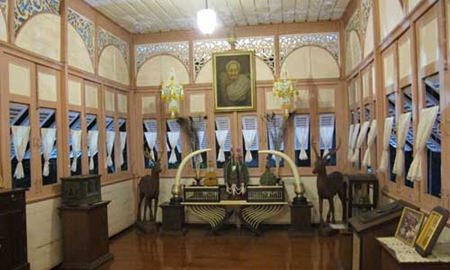 Exhibition room at Ban Vongburi.
Exhibition room at Ban Vongburi.
This was fascinating to me – a nugget of history that few people knew. I began to think that there was a lot more to this sleepy provincial town than initially met the eye.
Phrae province is around 200 km from Chiang Mai and about 560 km from Bangkok. It is often bypassed by tourists who tend to head to the neighbouring province of Nan.
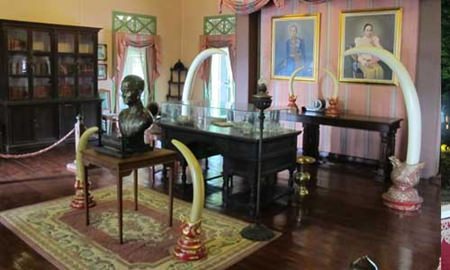 Khum Chao Luang Moueng Phrae.
Khum Chao Luang Moueng Phrae.
But in the past, it was Phrae that dominated the region, thanks to it being the centre of the teak logging industry: people came from the world over to trade and there was a great deal of Western influence. This is clearly seen in the colonial-style buildings and gingerbread houses which are scattered around the city.
The most prominent of these houses is that of Khum Chao Luang Muang Phrae or the House of Phrae’s Governor. Built in 1892, the old teakwood palace, called Khum in the northern dialect, is an exquisite two-storey colonial building painted a striking green and decorated with beautiful fretwork. It showcases a blend of East and West that will be familiar to anyone who has visited Bangkok’s Vimanmek Mansion, a residence of King Rama V the Great. Such buildings are reminders of the influence that the colonial powers had in Thailand at the time, despite never actually conquering the kingdom.
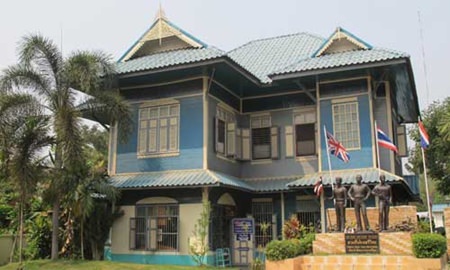 The blue building is now the Free Thai Movement Museum telling stories of Thailand during WW II.
The blue building is now the Free Thai Movement Museum telling stories of Thailand during WW II.
Today, Khum Chao Luang Muang Phrae has been converted into a museum. The upper floor exhibits everyday items; such as, household goods, furniture and photos of the governor and his family. It’s all very interesting but the greatest surprise lies in the building’s cellar.
It seems that Khum Chao Luang’s basement was once used to imprison slaves who were being held for committing serious crimes. These wretched creatures, many of whom were facing the death penalty were kept in complete darkness within a windowless retention room. Little wonder the locals whisper of ghosts to this day – the spirits of slain prisoners haunting the living.
There is certainly a chilling atmosphere, so with a shiver I moved on to the next attraction in the town, Ban Vongburi.
This beautiful pink shaded house is eye-catching and is even more stunning closer up thanks to its elaborate wood-carving. Now an open museum, Ban Vongburi, features 20 exhibition rooms that showcase the family’s household items, ancient artefacts, furniture, earthenware, silverware, as well as fascinating photos from the period. There are also some poignant documents about the trading of slaves and diamonds on exhibit as well – a reminder of how in the recent past, people were merely commodities like any other.
Another interesting attraction, the Seri Thai Museum can be found behind the Paradorn Hotel. This was once home to the Kanthatham family and the exquisite blue teak house played a vital role in Thai history during World War II, as a coordination centre for the Free Thai Movement.
The Free Thai Movement or Seri Thai was an underground movement of Thais who actively resisted the invading Japanese when Siam declared war against the Allies during World War II. They set up networks within the USA, the UK and Thailand itself and worked against the Japanese and their puppet Thai government.
The Kanthatham house was Seri Thai’s centre of operations in Northern Thailand and was vital to the freedom fighters. But so secretive was the movement that the stories of their successful missions were nearly lost in the mists of time. Luckily for visitors, the family’s descendents have collected documents and stories that tell the tales of their brave ancestors some of whom are commemorated in sculptures in front of the house – three brothers of the Kanthatham family who were northern leaders of the Free Thai Movement.
Inside, there are displays of old weapons and shells that were used during the struggle. There are also photos of important Seri Thai leaders. Information is in Thai and English and the museum is open every day. Admission is free but the Museum depends on donations, so do leave a few Baht to ensure this fascinating history of these brave people can continue to be told. And do try and visit on a day that the Museum owners are at home. They are always eager to tell the tales of their brave ancestors.
Take a break:
If you fancy a break from the historical tours, there are lots of creative things to do in Phrae.
Phrae is well-known for its traditional cloth making and the most famous of these are Mo Hom garments, which are made of cotton and dyed naturally with indigo.
You can try making your own Mo hom souvenirs at the Thung Hong village, about 4 km off Highway No. 101. They run workshops where you can learn about the cloth and how to make your own. If you don’t feel like weaving, there is also a shop with good quality blue Mo hom shirt and products.
Phrae by Night: Every Saturday night, there is a Kat Phra Non walking street near Ban Wongburi. The market features local food, traditional music and performances by local artists. It’s a good place for souvenirs and local goods. The market is open from 15:00 – 20:00 hrs.
Getting around:
City tours can be enjoyed by hiring a rickshaw to see the main city sights for 200-300 Baht per person depending on the distance. Please note that many drivers do not speak English.
Accommodation
Huern Na Na: www.huernnana.com. Room rates ranges from 2,600 – 5,500 Baht.
Paradorn Hote: Room rates are around 250-600 Baht. Tel: +66 (0) 5451 1177, +66 (0) 5451 1059, +66 (0) 5452 1719.
Getting there
By Plane: Nok Air operates four flights a week on the Bangkok (Don Mueang) –
Phrae route.
By Car: From Bangkok, take Highway No. 1 and Highway No. 11 to Phrae via
Nakhon Sawan, Phichit, Phitsanulok and Uttaradit.
The distance is around 555 km.
By Bus: There are air-conditioned coaches from the Northern Bus Terminal (Mo Chit) on Bangkok’s Kamphaeng Phet 2 Road.


